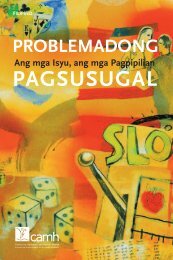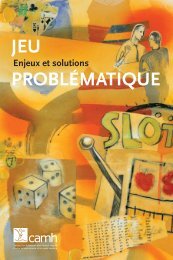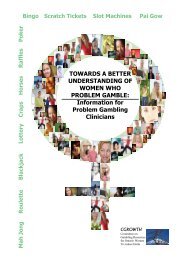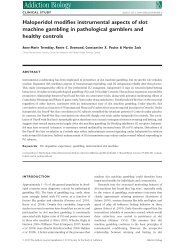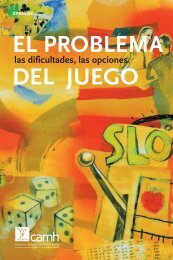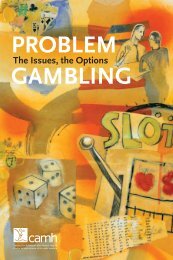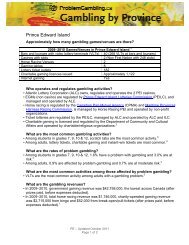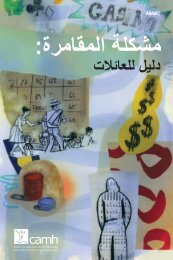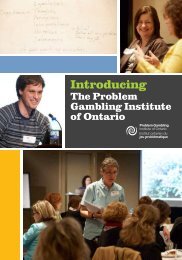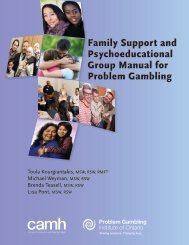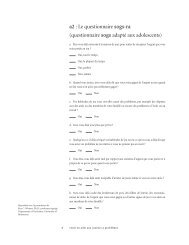Youth Making Choices: Gambling Prevention Program
Youth Making Choices: Gambling Prevention Program
Youth Making Choices: Gambling Prevention Program
Create successful ePaper yourself
Turn your PDF publications into a flip-book with our unique Google optimized e-Paper software.
Unit 3: ProbabilityAppendix BTeacher Resource 1 p. 25. Most people believe that after you win you are less likely to win again. Because of this,people sometimes switch numbers, or switch machines after a big win. As students to lookat the first number they rolled. Ask how many of them rolled the same number again on the2nd roll, how many rolled the first number on the 3rd roll and so on. Make a graph of howstudents repeated the first number on the 2nd, 3rd, 4th, 5th, 6th and 7th rolls of the dice. Onaverage the number should have been repeated on the 2nd, 3rd, 4th, 5th, 6th and 7th rollsof the dice approximately 16.7% of the time. The results should illustrate that after a numberhas come up it is neither more likely nor less likely to come up again. Ask them how manyrolled the same number more than once in the next 6 rolls. About 26% of the class shouldreport getting the same number more than once. Ask did not repeat the same number in thenext 6 rolls. About 33% of the class should report that they did not repeat the same number.This belief that a number is less likely to come up again can lead some people to believe theycan beat the house edge of the game by avoiding numbers that have come up recently or bylooking for numbers that are due to come up. This exercise will demonstrate that the odds ofa number do not change after a number has come up.6. Finally, combine the results from all students to see if the total of all the students is closerto 16.6%.Introduction to Sections Five through EightNext, the students are introduced to the concept of house edge. House edge is the profit thecasino makes from people who gamble. In sections Five through Eight, students see howcasinos make their money by not paying back enough money to the players to make up forthe money the player has lost. Sections Five through Eight demonstrate how the casino canguarantee a profit by varying the amount paid back to the player. The students can work this outwith both their individual tally sheets results (wins and losses) and with the group results. Thegroup results will be closer to the true long-term percentages. In Section Five, there is no houseedge so the casino would not make any profit.Procedure• Using the results from the tally sheets, place the results in sections Five through Eight.Starting in Section Five, students assume a bet size of 1 penny for every roll of the dice anda prize value of 6 pennies for every win. Compute the house edge assuming a prize of 6pennies per win. This can be computed for both individual and group data.• As a group, discuss the outcome and house edge. On average there should be a zero houseedge because the prize of 6 pennies is large enough to make up for the chances of losing.• Now repeat this using a win amount of only 5 pennies for a win. A prize of only 5 penniesshould result in an outcome of a net loss of 15 pennies and a house edge of 16.7%.• Now repeat this with a win amount of only 4 pennies for a win. A prize of only 4 penniesshould result in an outcome of a net loss of 30 pennies and a house edge of 33.3%.• Now repeat this with a win amount of 7 pennies for a win. A prize of 7 pennies should resultin an outcome of a net win of 15 pennies and a house edge of –16.7% (or a player advantageof 16.7%).• Which of these games is the most realistic for a commercial casino: a prize of 6, 5, 4 or 7pennies for a 1-penny bet? The answer is 5. With 6 or 7 the casino would lose money, andwith 4 the player would lose too much, bet bored and go home.<strong>Youth</strong> <strong>Making</strong> <strong>Choices</strong>: <strong>Gambling</strong> <strong>Prevention</strong> <strong>Program</strong>www.Problem<strong>Gambling</strong>.ca3.22




